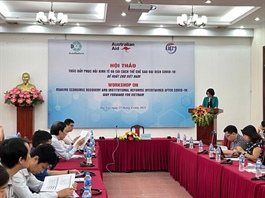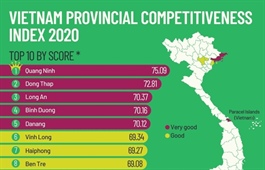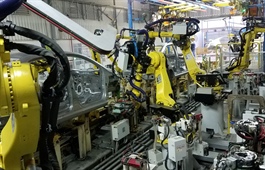Positive growth revisions on the cards after resilient Q1
Positive growth revisions on the cards after resilient Q1
With its relatively good economic growth in the first quarter driven by surging manufacturing and processing activities and strong control of COVID-19, Vietnam has earned more praise from high-profile international organisations that are expected to revise up the country’s growth outlook this year.
|
Despite difficulties, the local logistics industry is still on the rise in this year’s first quarter thanks to many reasons, including the global economic recovery. For CEVA Logistics Vietnam, recovery means the company can boost recruitment and expand its network to ship goods to the US, which considered Vietnam its eighth-largest trade partner in the first quarter of 2021.
“In Vietnam, the company’s total revenue in the first three months from freight shipping grew about 30 per cent on-year,” Nguyen Thanh Van, head of Contract Logistics at CEVA Logistics Vietnam, told VIR. “It is expected that the rate will be about 20-25 per cent for the whole year.”
According to Van, many other logistics firms are also performing well thanks to a rise in exports and an increase in global trade, as well as the government’s good control of COVID-19 helping raise business confidence and domestic production.
Last June, CEVA expanded its contract logistics footprint in Vietnam with a new multi-user facility in the southern province of Dong Nai. Spanning over 10,000 square metres, the warehouse is serving as a distribution centre for the Ho Chi Minh City area and will become a main hub to connect south and central Vietnam. The facility is strategically located with easy access to Cat Lai Port and Tan Son Nhat International Airport.
According to the General Statistics Office (GSO), firms like CEVA Logistics Vietnam have contributed greatly to the country’s goods transportation which hit 153.6 million tonnes in March, up 5.3 per cent on-month. The volume in the first quarter of the year reached 472.6 million tonnes, up 10.2 per cent, far higher than the 1.1 per cent growth on-year in the same period last year.
Along with uptrends in logistics, the first-quarter manufacturing and processing industry also grew 9.45 per cent on-year in the first quarter, higher than the on-year climb of 7.12 per cent in the corresponding period last year. Manufacturing and processing currently create 80 per cent of Vietnam’s industrial growth.
In an example, Japanese-invested FCC Vietnam Co., Ltd. at Hanoi’s Thang Long Industrial Park is operating three workshops producing a variety of car and motorcycle clutches, related components, and other spare parts for Honda, Suzuki, and Yamaha, and also for export to the US.
Do Hong Minh is among over 1,200 workers at the company. His average income from the work has increased by another VND1 million ($43.50) per month, as compared to last December. “The company will import eight new lathes in May worth about VND50 billion ($2.1 million) for our workshop, meaning another 30 new workers will be needed,” Minh told VIR. “Since early this year, we have become much busier as the company has landed many new orders from US partners who want to buy new products from FCC.”
Previously COVID-19 forced the company to reduce production costs. Over 200 local workers faced a layoff but still got 70 per cent of their monthly salary. Currently, all workers are working at full speed, with a rise in income.
According to the GSO, the Vietnamese economy in general is bouncing back. In the first quarter of 2021, it grew 4.48 per cent on-year, higher than the on-year climb of 3.82 per cent in the same period last year.
| On April 15, Prime Minister Pham Minh Chinh hosted his first government cabinet meeting after the governmnent’s new personel group made a debut at the recent 11th session of the 14th National Assembly.
The PM ordered government members to continue concentrating on building the government and administrative agencies of all levels into a bloc with high solidarity, consensus, integrity, democracy, strengthened discipline and order, and with practical and effective activities in service of the public and enteprises, ensuring openness, transparency, and accountability. Heads of units’ responsibility in setting examples and exemplariness are to be enhanced. The PM also ordered government members to timely remove difficulties for production and business activities, and develop domestic trade and tourism markets, while ensuring stable development of the local real estate and stock markets. Efforts are to continue being made to improve the domestic business climate and mobilise and effectively use all resources for national development via effective and sound institutions, mechanisms, and policies. The government also agreed to enact a decree on extending time for tax payment and land use payment in 2021. The Ministry of Labour, Invalids, and Social Affairs is required to review and assess the effectiveness of the implementation of governmental resolutions on measures for supporting those vulnerable to COVID-19. Results must be reported to the prime minister. |
Positive forecasts
A number of high-profile organisations are to revise up the economy’s outlook for this year and beyond, saying that manufacturing and processing, and a bigger inflow of foreign direct investment (FDI) will continue serving as the key pillars for economic growth in the time to come.
On April 28, the Asian Development Bank (ADB) in Vietnam will release its updated Asian Development Outlook report, with an expectation that it will revise up its projection for the Vietnamese economy’s growth this year. Last December, it forecast that Vietnam might grow 6.1 per cent in 2021. The ADB has said that Vietnam is showing “stronger resilience than most comparable economies, and the economy’s outlook over the medium and long term remains positive. Economic fundamentals have not been impaired, and Vietnam looks likely to benefit from current trends in global patterns of trade, investment, and production.”
According to the ADB, investment in 2021 will be boosted by improving disbursement of public investment, the continuing diversion of production from China to Vietnam, recovery in China’s economy, and the implementation of a trade agreement with the European Union to greatly liberalise trade.
Two weeks ago, former Prime Minister Nguyen Xuan Phuc, who is now State President, said that Vietnam has become a safe destination for investment. Many international organisations have praised the economy’s potential and outlook for this year, including HSBC with 7 per cent growth projected, the International Monetary Fund (IMF) at 6.5 per cent, and the International Finance Corporation at 6.5 per cent in the 2021-2026 period, while Moody’s has changed Vietnam’s economic outlook to “positive” from “negative.”
As of March 20, total registered FDI reached $10.13 billion, an on-year climb of 18.5 per cent. Total disbursement in the first three months of 2020 is estimated to touch $4.1 billion, up 6.5 per cent on-year.
The IMF said that Vietnam’s economic outlook is expected to “remain brighter in 2021 thanks to the government’s pro-business policies and good control of COVID-19, which have helped strengthen the confidence of enterprises and investors. Growth is projected to strengthen to 6.5 per cent in 2021 as normalisation of economic activity continues, businesses recover, and private consumption and business climate rebound.”
Manufacturing and retail sales are expected to lead the recovery, while the travel and hospitality services will remain subdued. Net exports will continue to contribute positively to growth as external demand picks up.
“FDI remained buoyant, with the increase largely coming from China in the manufacturing sector. By end-2019, total committed Chinese FDI was estimated at around $16.3 billion, accounting for around 5 per cent of total accumulated FDI to Vietnam (20 per cent if Hong Kong, China, and Taiwan are combined),” said the IMF report.
Last week, Fitch Ratings told VIR they “expect stronger economic activity in 2021 [in Vietnam] – in which we forecast real GDP growth of 8.6 per cent – driven by manufacturing, construction and services, to spur higher loan demand over the year.”
In particular, trade gains from free trade agreements with the EU and the UK, as well as the Regional Comprehensive Economic Partnership, will provide a further thrust to export manufacturing on top of the gains in production since 2018 which come from manufacturing supply chain relocation from China, Fitch Ratings said.
A rise in local production has also prompted Fitch to forecast “Vietnam’s credit growth to be 12 per cent in 2021, in line with the central bank, up from an estimated 10.1 per cent in 2020.” In Vietnam, almost all loans of businesses come from bank loans.
Expectations
One month ago, the IMF’s Executive Board wrapped up consultation with Vietnam. The IMF executive directors noted that the pandemic disrupted a prolonged period of high growth and improvements in living standards. They commended the authorities for their decisive and comprehensive response to the pandemic, which, supported by strong fundamentals and policy buffers, has been instrumental in ensuring the economy’s resilience.
Directors stressed the importance of structural reforms to improve the business environment, enhance productivity, and boost post-pandemic potential growth. They concurred that priority should be given to reducing labour skill-mismatches, promoting digital transformation, and ensuring a level playing field. Directors welcomed continued efforts to improve economic institutions and strengthen governance.
As for Van from CEVA Logistics Vietnam, he said that all enterprises like CEVA want a level playing field which can help the economy reach higher growth.
“More administrative reforms need boosting because firms are still facing complicated procedures in tax payment and customs clearance, for example, hampering them from reducing production and business costs,” Van told VIR.
Meanwhile, Minh from FCC Vietnam told VIR that he felt optimistic over his work, and believed in the economy’s outlook.
“Our company is expanding its workshops, meaning we will have more work to do,” he said. “More administrative reform will help companies like mine perform better. This will also mean that over 1,200 workers at the company will have more income to feed their families.”






















